01 December 2023: Database Analysis
Unveiling the Research Landscape and Emerging Trends in Cell Cycle for Cancer Immunotherapy: A Bibliometric Analysis (1990–2022)
Cheng Feng1BCDE, Yuan Li1ABC, Mengya Zang2DF, E-er-man-bie-ke Jin-si-han1BF, Meng HeDOI: 10.12659/MSM.940556
Med Sci Monit 2023; 29:e940556
Abstract
BACKGROUND: The direct and indirect roles of the cell cycle in immunology of the tumor microenvironment (TME) are topics of intense scientific interest. Therefore, this study aimed to investigate the knowledge domain and hotspots related to the cell cycle for cancer immunology applications.
MATERIAL AND METHODS: The Web of Science Core Collection (WoSCC) was used as a powerful tool for identifying articles related to cell cycle for cancer immunology applications. Co-occurrence relationships were examined with R, VOSviewer, and CiteSpace software. Related research hotspots and possible future trends were also examined.
RESULTS: A total of 1844 qualified English-language documents were obtained in WoSCC between 1999 and 2022, with a 7.66% annual growth rate. These eligible studies were co-authored by 2246 institutions in 51 countries/regions, with the greatest article number being published in the United States (36%, 664/1844), followed by China (19%, 351/1844) and Germany (4.5%, 83/1844). The top 3 institutions with the most publications and the top 3 academic journals (n=390 in total) on this topic that published the most articles were identified. Key nodes from the co-cited network were aggregated and identified to reveal the shift in cell cycle for cancer immunology applications. Notably, the current research hotspots in this field include “tumor progression”, “chemotherapy”, “resistance”, “clinical trial”, and “target population”.
CONCLUSIONS: This study revealed field profiles, research hotspots, and future directions of cell cycle dysregulation-related immunology, and the findings will offer a vigorous roadmap for further studies in the combination therapy of cell cycle inhibitors and immune checkpoint inhibitors for treating various cancers. Our results can shed more light on relevant research in this field.
Keywords: Cell Cycle, tumor microenvironment, Immunotherapy, Neoplasms
Background
The cell cycle represents the fundamental biological phenomenon, and its dysregulation is a characteristic of malignant illnesses that significantly affect various tumor behavior aspects. Anti-cell cycle treatment can achieve promising outcomes in several malignant illnesses in different cancers [1]. However, it is still necessary to further understand the cell cycle, particularly the role of tumor immunology [2]. Recent studies have shown that mutations or amplifications of cyclin-dependent kinases (CDK) and its regulators (eg, INK4 and CIP/KIP) lead to abnormal CDK protein expression, thus resulting in abnormal cell proliferation and promoting tumor development [3]. Moreover, further research has discovered that selective CDK inhibitors can promote the arrest of the cancer cell cycle and enhance anti-tumor immunity [4], consistent with the results obtained by Minton, who reported that cell cycle inhibitors boosted tumor immunogenicity [5].
Over the past decade, immune checkpoint inhibitors (ICIs) have emerged as a revolutionary cancer treatment modality, offering long-lasting responses and survival benefits for a substantial number of cancer patients. However, only 20–40% of patients derive benefit from these new therapies. PD-L1, an important immunosuppressive molecule, has been utilized as a biomarker for guiding the selection of eligible patients for ICIs therapy [6]. PD-L1 protein level fluctuates in the process of cell cycle progression and modulates its stability protein via cell cycle kinase, indicating that the combination therapy with PD-1/PD-L1 immune checkpoint blockers and CDK inhibitors may be used to improve the clinical outcomes of cancer patients [7,8]. Some studies have indicated that the DNA damage repair-mediated inflammatory signaling pathway, which arrests cell cycle progression, has restricted the efficacy of some tumor immunotherapies [9–13]. Therefore, as the PD-1/PD-L1 pathway is not the sole limiting factor of anti-tumor immunity, it has been validated that combining ICIs with other novel targeted therapies, such as CDK inhibitors, can contribute to superior anti-tumor efficacy [14,15].
At present, numerous excellent articles have been published concerning the applications of cell cycle dysregulation for tumor genesis and development. However, a comprehensive study assessing these relevant publications is lacking about the TME, especially for the role of immunology. Additionally, numerous critical facts are overlooked by researchers because they just explore relevant studies from only 1 or a few perspectives. It remains challenging for investigators to analyze relationships across countries, institutions, and authors, as well as references based on excessive relevant literature. Bibliometrics, a powerful tool that utilizes statistical and mathematical approaches for the quantitative analysis of numerous studies in a specific research field, addresses these problems. Currently, scientometric analysis of relevant studies is mostly conducted using CiteSpace, VOSviewer, and the R package “bibliometrix.” These tools have been used by many researchers for assessing research hotspots, knowledge domain, and frontiers in the relevant topic, based on analysis results.
However, scientometric analysis on data regarding cell cycle mapping in immunology is lacking at present. Consequently, the present work aimed to assess studies associated with use of the cell cycle for cancer immunology applications from 1999 to 2022, to depict the current situation in this field and identify novel research directions.
Material and Methods
DATA EXTRACTION AND SEARCH STRATEGY:
The Web of Science Core Collection (WoSCC) database was comprehensively searched to retrieve articles related to cell cycle and immunology published from 1999 to December 1st, 2022. The search formula below was used, TS= (Neoplasm* OR Tumor* OR Cancer*) AND TS=(cell cycle) AND TS=(immunology* OR immunity*). The collected baseline data and study inclusion criteria were: (1) articles based on the theme of cancer cell cycle for immunology, with available data on authors, titles, abstracts, institutions, journals, country/region, keywords, and references; (2) document types including articles and reviews; and (3) articles written in English. The study exclusion criteria were data papers, book chapters, proceedings papers, meeting abstracts, duplicates, editorials, and unpublished articles with insufficient data. Any disagreement was resolved by consulting a senior physician. The study flowchart is shown in Figure 1. As this study was based solely on the literature, the requirement to obtain informed consent or approval from the institutional review board was waived.
STATISTICAL METHODS:
Relevant data were collected and processed using an automatic algorithm and machine intelligence in the bibliometric software. In this study, the institutions, countries or regions, journals, and keywords of publication traits were collected. Moreover, the H-index, which reflects the scientific research value, was also considered [15]. Our analysis was conducted using the bibliometrix package in R software, which involves various statistical methods, including machine learning theory (see https://www.bibliometrix.org/vignettes/Introduction_to_bibliometrix.html for more details). VOSviewer (1.6.18) and CiteSpace (5.7.R5) were utilized to analyze collaboration networks and identify burst keywords through reference citation analysis.
Results
OVERALL INFORMATION ON PUBLICATIONS:
Altogether, 1844 qualified publications that met the eligibility criteria regarding cell cycle for cancer immunology were identified from the WoSCC database (Figure 2A). In this field, a total of 11 834 authors from around the world participated in the included studies, and the average annual article growth rate was 7.66%. According to our results, this research field is a relatively new one, with an average publication age of 8.21 years (Figure 2B). Importantly, the annual publication number showed an increasing trend over time from 1999, reaching a peak in 2022 (in total, 202 articles were expected to be published). Over the last 10 years, publication numbers regarding this topic rapidly increased, accounting for 65.52% of overall publications. Additionally, the annual mean article citations concerning cancer cell cycle for immunology applications also showed a rapid growth trend (Figure 2C).
ANALYSIS ON COUNTRIES/REGIONS AND INSTITUTIONS:
Altogether, 1844 publications related to the cancer cell cycle for immunology met the eligibility criteria, which were co-authored by 2246 institutions in 51 countries/regions. The international distribution of scientific production according to country in this field are depicted in Figure 3A. Clearly, those 10 most prolific countries who published the most publications are from 4 continents: 4 from Europe (Germany, UK, France, Italy), 3 from Asia (China, Japan, Iran), 2 from North America (the USA, Canada), and 1 from Oceania (Australia). These are all developed countries, with the exception of Iran and China (Figure 3B). The publication numbers arranged by the countries of corresponding authors are displayed in Table 1. Apparently, the USA published the greatest number of publications (36%, 664/1844), while China (19%, 351/1844) and Germany (4.5%, 83/1844) ranked second and third, respectively. Moreover, the USA was the first to investigate the cancer cell cycle for immunology application and had more publications than the other countries (Figure 3C). Among those 10 most prolific countries, the USA was the most prolific and had a higher citation rate, implying the high quality of its publications.
The bibliometric network maps plotted with Bibliometrix displayed the international collaborative relationships between various countries/regions (Figure 4A). As revealed by the maps, the countries/regions with most publications also had the most nodes, suggesting that international collaboration was beneficial for research result output (Figure 4B). However, based on these maps, although the United States and China had the most publications, their collaboration was not as close as that of the European countries.
In terms of institutions, those 10 most prolific institutions regarding the cell cycle for cancer immunology applications are presented in Figure 5A and Table 2. Of them, 7 were in the United States. The University of Montreal was the most prolific institution (n=83), accounting for 1.25% of all publications. Additionally, since the first investigation on cancer cell cycle for immunology applications in 1999, the University of Montreal maintained the highest publication output. By contrast, Johns Hopkins University did not begin research in this field until 2011, but its publication output rapidly increased (Figure 5B). On inter-agency cooperation, the US academic institutions exhibited greater nodes, suggesting the higher degree of institutional cooperation. Furthermore, several research institutions in China (Sun Yat-sen University, Central South University, Shanghai Jiao Tong University, and Fudan University) also exhibited greater nodes, demonstrating their close institutional coordination (Figure 5C). Nonetheless, collaboration between these institutions and those in the USA was lacking.
ANALYSIS OF THE CORE AUTHORS CONTRIBUTING TO PUBLICATIONS:
A total of 11 834 researchers co-authored the 1844 articles related to use of the cell cycle for cancer immunology applications. The results indicate a strong co-occurrence relationship among authors, with authors who have higher productivity often co-occurring more frequently with other authors. According to Lotka’s law on author productivity, most authors authored ≤2 documents, with 88.3% and 96.9% of them authoring 1 and 2 documents, respectively (Figure 6A). In a network map showing relations of author collaboration, large nodes were observed, which suggested the importance of coordination in research result output (Figure 6B). Figure 6C presents the authors’ production over time, where Zhang had the longest timeline, from 2004 to 2020. The top-impact authors measured using H-index are presented in Figure 6D, showing that Wira, Thibault, and Baradaran were the top 3 authors.
INVOLVED JOURNALS AND DOCUMENTS REGARDING THE CANCER CELL CYCLE FOR IMMUNOLOGY APPLICATIONS:
Altogether, 108 academic journals concerning the topic of cancer cell cycle for immunology applications were analyzed. According to our results, the Journal of Immunology was the most prolific (n=262), and Frontiers in Immunology (n=258) and Cancer Immunology Immunotherapy (n=129) ranked second and third, respectively (Figure 7A). Also, among those prolific academic journals, the 3 core sources of academic journals were the Journal of Immunology, Frontiers in Immunology, and Cancer Immunology Immunotherapy (Figure 7B). Figure 7C displays the top 10 journals with greatest H-index impact, with Journal of Immunology (h-index=64) ranking first, followed by Cancer Immunology Immunotherapy (h-index=34) and Nature Immunology (h-index=34). The network map in Figure 7D shows 2 main clusters of academic journals, with diverse journals exhibiting positive citation relations. Additionally, sources with the highest local citations were explored. Table 3 displays the 10 most locally cited journals and Table 4 displays the most globally cited documents.
KEYWORDS DEVELOPMENT OF CELL CYCLE FOR CANCER IMMUNOLOGY APPLICATIONS:
The keyword co-occurrence analysis was conducted on 1844 articles related to cancer cell cycle and immunology applications, and the top relevant keywords were identified (Table 5). These keywords are presented as a bar diagram and a word cloud (Figure 8A). Further, a tree map of the top keywords was created to visualize their frequency of occurrence (Figure 8B). Thereafter, clustering analysis of the keywords was conducted, as represented by different colors in Figure 8C, with thicker inter-node lines indicating stronger associations between the keywords. In addition, trend analysis of the top keywords revealed that the research focus shifted over time. The current research hotspots in this field are “tumor progression”, “chemotherapy”, “resistance”, “clinical trial”, and “target population” (Figure 8D).
Discussion
COUNTRIES/REGIONS, INSTITUTIONS AND INSTITUTION COOPERATION:
The United States, China, and Germany published the most studies, accounting for over half (59.5%) of the published articles. The top 10 countries are from 4 continents, with China and Iran being the only developing countries. The United States (36%, 664/1844) was the most prolific. While there was close coordination among institutions and countries, stronger coordination was observed between the United States and other countries compared with that among countries outside the United States. The distribution of institutions conformed to that of countries, suggesting the importance of international cooperation.
Those 10 most prolific countries are from 4 continents, including 4 from Europe (Germany, the UK, France, Italy), 3 from Asia (China, Japan, Iran), 2 from North America (the USA, Canada), and 1 from Oceania (Australia). These countries are developed countries with the exception of Iran and China. Two of those 10 institutions were from China, while the other 8 were from the United States. However, there was no much international coordination between Chinese and US institutions in the field. Therefore, more close collaboration in cell cycle research for immunology applications is needed to promote advancements in the topic. Additionally, an obvious gap between developed and developing countries exists, which indicates that developing countries may put additional investments in the field and search for close coordination with developed countries.
AUTHORS AND CITED AUTHORS:
Those 3 most active authors were Baradaran, Wira, and Wang, who collectively published at least 17 articles. These 3 authors had a significant impact on cell cycle and immunology research, and made tremendous contributions to research in this field. With regard to H-index, Wira ranked first, followed by Thibault, Baradaran, Wang, and Zhang. Baradaran, from Tabriz University of Medical Sciences, ranked the first among all the co-cited authors. His research on micro-RNA integrated issues of gene expression, oncology, bioinformatics, disease, and cell cycle. Moreover, his biological studies span a wide range of topics, including receptor and blockade, while his recent cancer study combined topics in areas such as genetics and immunology, demonstrating the breadth of his expertise in the field.
JOURNALS AND CITED JOURNALS:
Out of 360 academic journals, 3 core sources-related journals – Journal of Immunology, Frontiers in Immunology, and Cancer Immunology Immunotherapy – were noteworthy, indicating that these journals had a particular interest in studies on use of the cell cycle for immunology applications. Additionally, the top 10 H-index impact rankings were led by the Journal of Immunology (H-index=64), followed by Cancer Immunology Immunotherapy (H-index=34) and Nature Immunology (H-index=34). There were 2 main clusters of academic journals identified, and diverse journals exhibited positive citation relations. Such data may help scientists select the most appropriate journals for submitting research on the cell cycle and immunology.
KEYWORDS:
In bibliometrics analysis, keywords are responsible for summarizing the core contents and research topics. Keyword bursts also indicate the research hotspots in the academic field, while time zone maps help exhibit novel hotspot evolution through keyword analysis [32,33]. Meanwhile, keyword co-occurrence analysis is applied in understanding research hotspot development and distribution in a specific field. Notably, research on cell cycle dysregulation in the early stage mainly focused on tumor proliferation, cell cycle, and apoptosis [34]. Understanding the immune status in TME can offer important data for dynamically monitoring immune responses and exploring combination therapy to provide survival benefits to more patients [35]. Therefore, subsequent research has shifted towards combining cell cycle checkpoint inhibitors and immunotherapy with a focus on anti-tumor metastasis, indicating more emphasizing on their clinical use [25–28,36–39]. Thus, the hotspots of keywords have recently shifted to “pembrolizumab”, “open-label”, “PD-1 blockade”, “blockade”, “invasion”, “migration”, “metastasis”, “target”, “resistance”, and “chemotherapy”.
Over the past decade, targeting PD-1 and PD-L1 has led to a new era in clinical cancer treatment. Nevertheless, the insufficiency in motivating efficient anticancer immunity through suppressing the PD-1/PD-L1 axis remains a problem to be resolved. It has been validated that cell cycle checkpoint combination treatments promote several process during the cancer immunity cycle, eliminate immunosuppressive brakes, and orchestrate the immune-supportive TME [40]. Together with multiple tumor models treatments, this reveals that the combination of PD-1, PD-L1, cytotoxic T lymphocyte–associated protein 4 (CTLA4) antibodies, or other immune checkpoint inhibitors with cell cycle-targeted therapy shows synergistic effects [41–45],which may become the new treatment strategies for clinical application.
Regarding mechanisms, cell cycle checkpoints have been suggested to be important for the activation of cGAS-STING-induced intrinsic immunity and anticancer immunity [41,42,46]. These studies demonstrate that pattern recognition receptors cGAS and STING levels are suppressed for evading immune surveillance [11,35,36]. Additionally, nuclear PD-L1 (nPD-L1) was also discovered to promote cell cycle progression independent of immunity within BRAF V600E-mutated colorectal cancer, which is not responsive to programmed cell death protein 1 (PD-1)/PD-L1 targeting immunotherapy [47]. Moreover, alterations in the DNA damage response pathway during the cell cycle have been identified as a biomarker and anti-tumor immunotherapeutic target [48]. According to Chen, G2/M checkpoint adaptation linked inflammatory pathway activation to anticancer immunity following DNA damage, thereby enhancing immune infiltration as well as anticancer immunity [11]. Furthermore, the keyword trends in research indicate that cell cycle division is becoming increasingly important for anti-tumor immunity.
Our research also has some limitations. Firstly, we only included data from WoSCC and excluded data from other public databases like PubMed, Embase, and Ovid, which may limit the representativeness of our findings. Secondly, only English-language articles were included, which may have introduced linguistic biases. Thirdly, high-quality studies with low citation rates may not have been included, leading to potential bias. Lastly, not all studies published in 2022 were included, and new data may potentially affect our final conclusions.
Conclusions
In conclusion, this scientometric and visual analysis provides a novel perspective on the current situation, development textures, research hotspots, and future directions of use of the cell cycle in cancer immunology research. By analyzing massive unstructured data in a stringent manner provided by computer statistics, our work empowers scholars interested in the cell cycle and immunotherapy to better understand the global research status and future development directions of this domain.
Figures
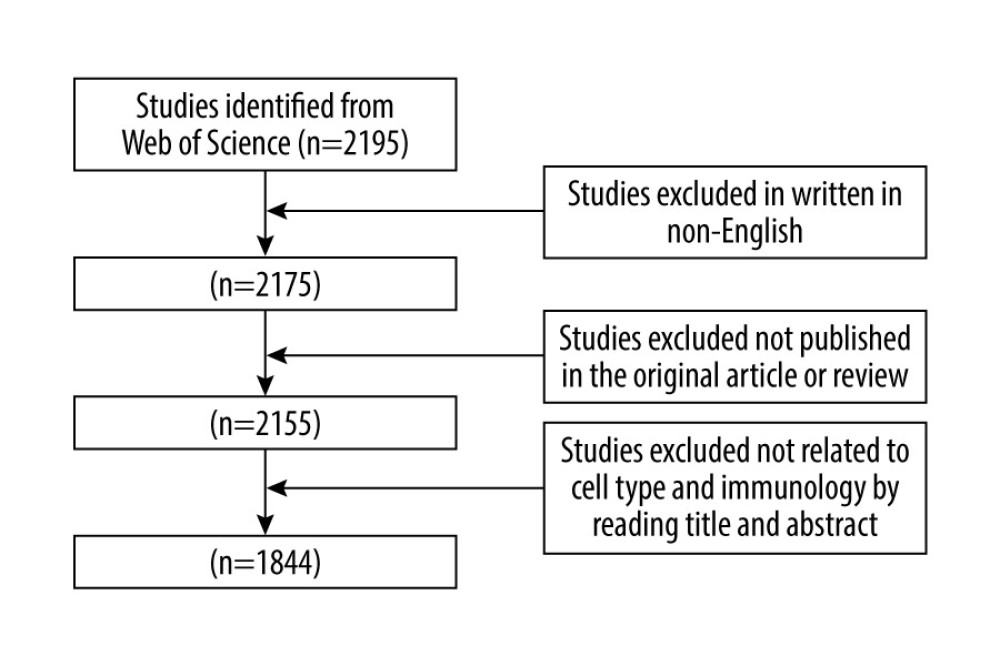 Figure 1. Data analysis flow chart.
Figure 1. Data analysis flow chart. 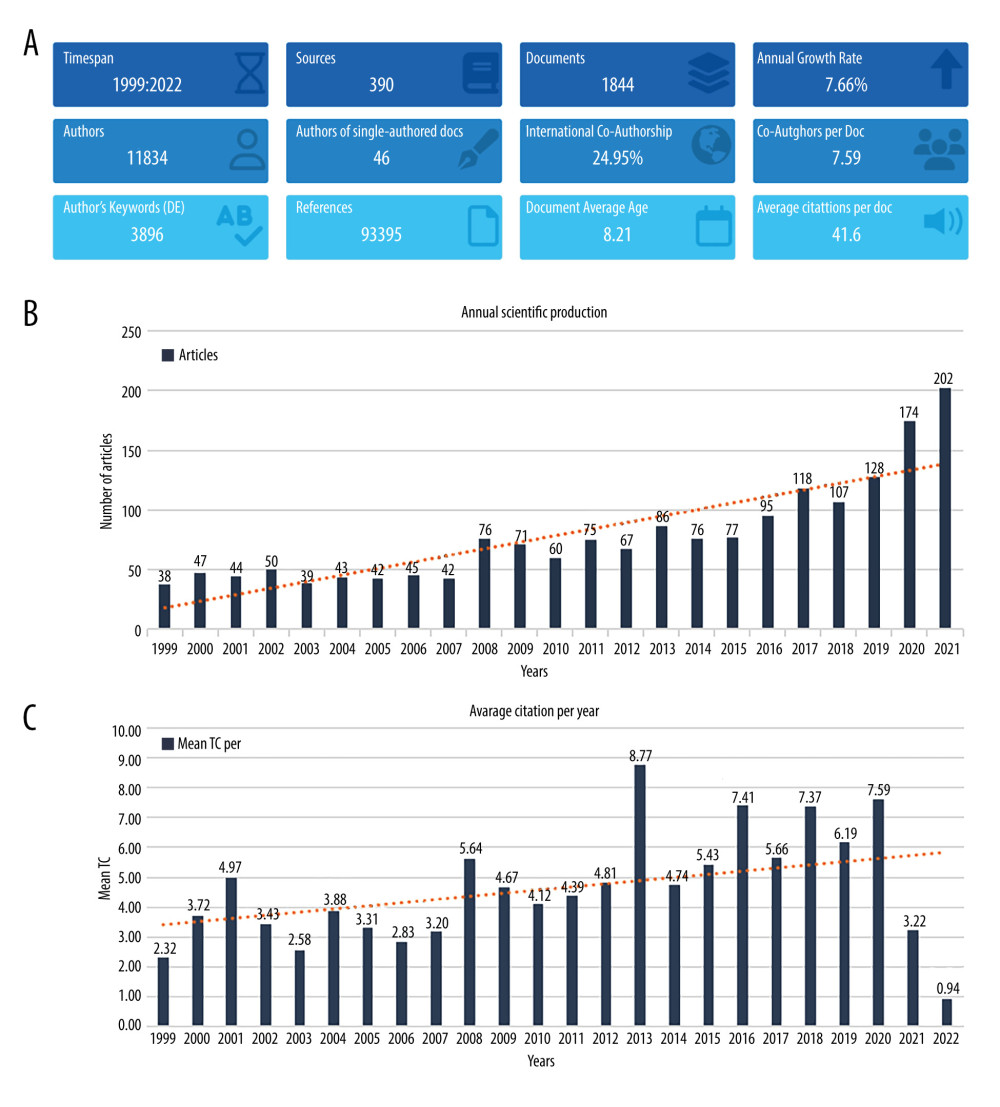 Figure 2. Overall information of publications using R(4.2.2) package “bibliometrix”(A) Main information. (B) Scientific production of articles regarding cell cycle in cancer immunology each year. (C) Average article citations per year of articles regarding cell cycle in cancer immunology.
Figure 2. Overall information of publications using R(4.2.2) package “bibliometrix”(A) Main information. (B) Scientific production of articles regarding cell cycle in cancer immunology each year. (C) Average article citations per year of articles regarding cell cycle in cancer immunology. 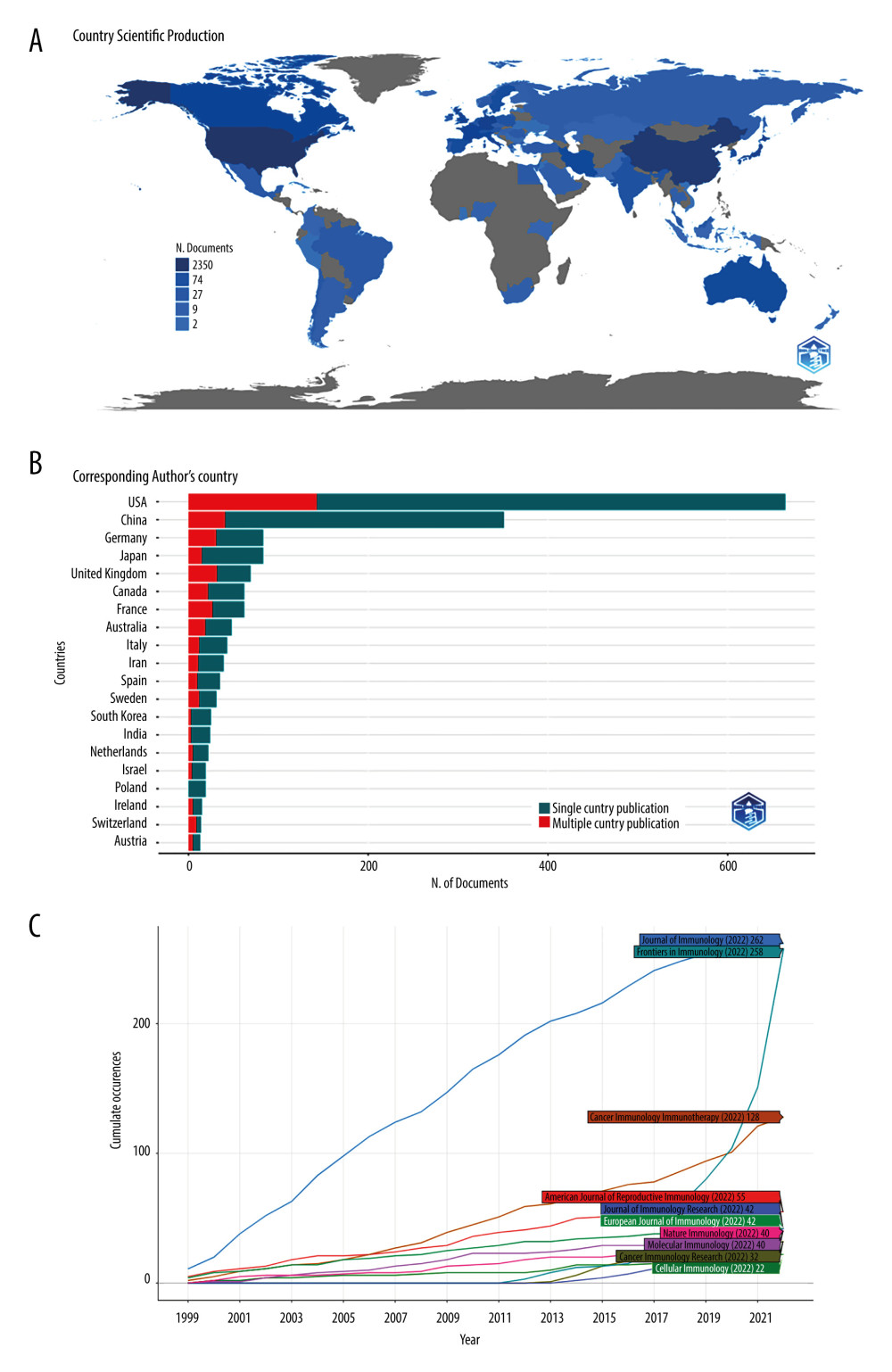 Figure 3. Top countries and relevant institutions that contributed to research on cell cycle in cancer immunology using R(4.2.2) package “bibliometrix”(A) International country map of publications; color depth stands for publication number. (B) Bar plot showing the 20 most prolific countries regarding cancer cell cycle for immunology in line with countries of corresponding authors. (C) Ten most prolific countries over time. MCP refers to multiple-country publications, while SCP indicates single-country publications.
Figure 3. Top countries and relevant institutions that contributed to research on cell cycle in cancer immunology using R(4.2.2) package “bibliometrix”(A) International country map of publications; color depth stands for publication number. (B) Bar plot showing the 20 most prolific countries regarding cancer cell cycle for immunology in line with countries of corresponding authors. (C) Ten most prolific countries over time. MCP refers to multiple-country publications, while SCP indicates single-country publications. 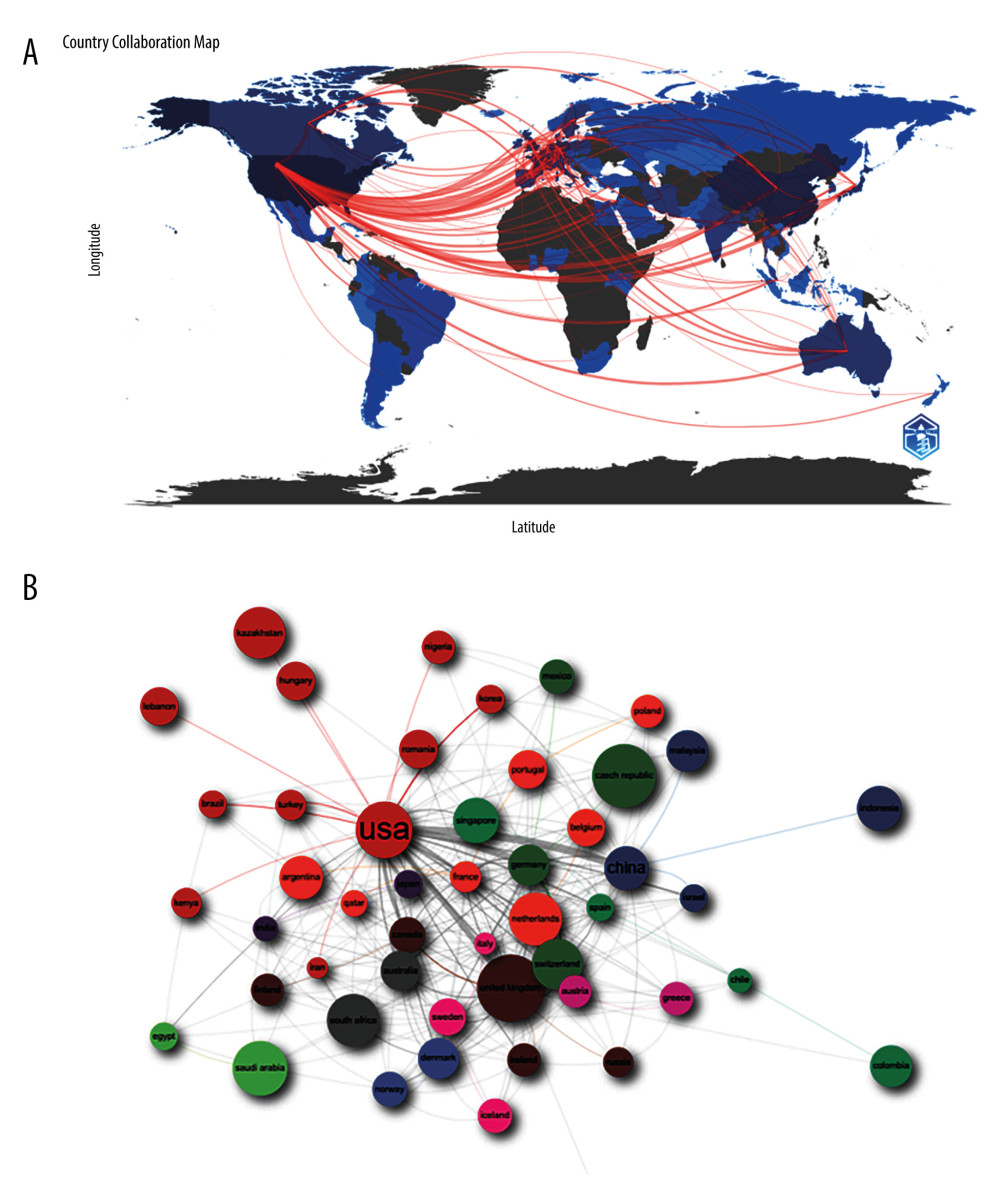 Figure 4. Visualization of the coordination between countries regarding research on the cancer cell cycle for immunology applications using R(4.2.2) package “bibliometrix”(A) Network map showing the coordination relations between countries. (B) Network map visualizing the coordination relations between countries.
Figure 4. Visualization of the coordination between countries regarding research on the cancer cell cycle for immunology applications using R(4.2.2) package “bibliometrix”(A) Network map showing the coordination relations between countries. (B) Network map visualizing the coordination relations between countries. 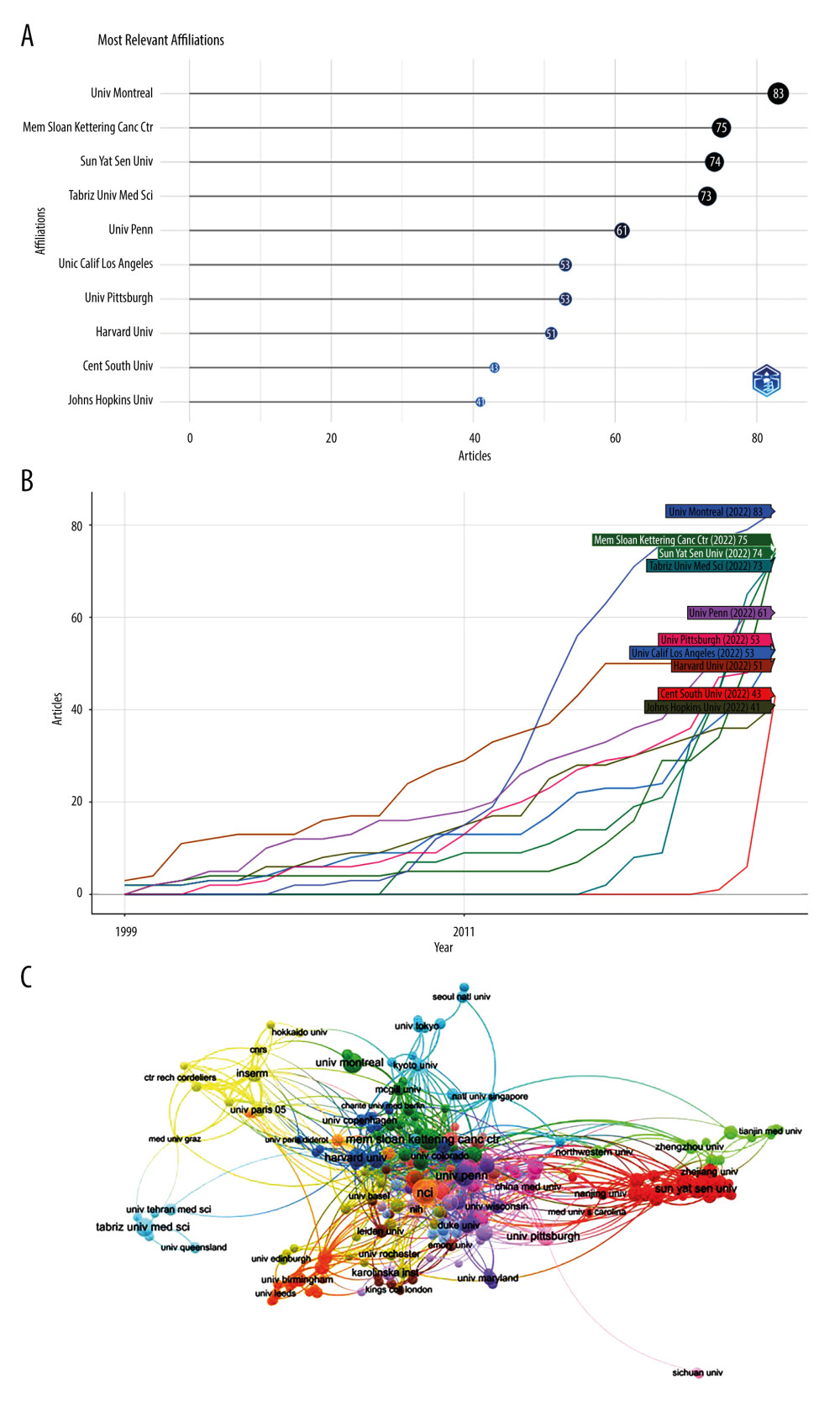 Figure 5. Visualization and analysis of institutions involved using VOSviewer (version 1.6.18) and the R package “bibliometrix”(A) Bar plot showing 10 most prolific institutions. (B) Production of those 10 most prolific institutions with time. (C) Network map showing related institutions.
Figure 5. Visualization and analysis of institutions involved using VOSviewer (version 1.6.18) and the R package “bibliometrix”(A) Bar plot showing 10 most prolific institutions. (B) Production of those 10 most prolific institutions with time. (C) Network map showing related institutions. 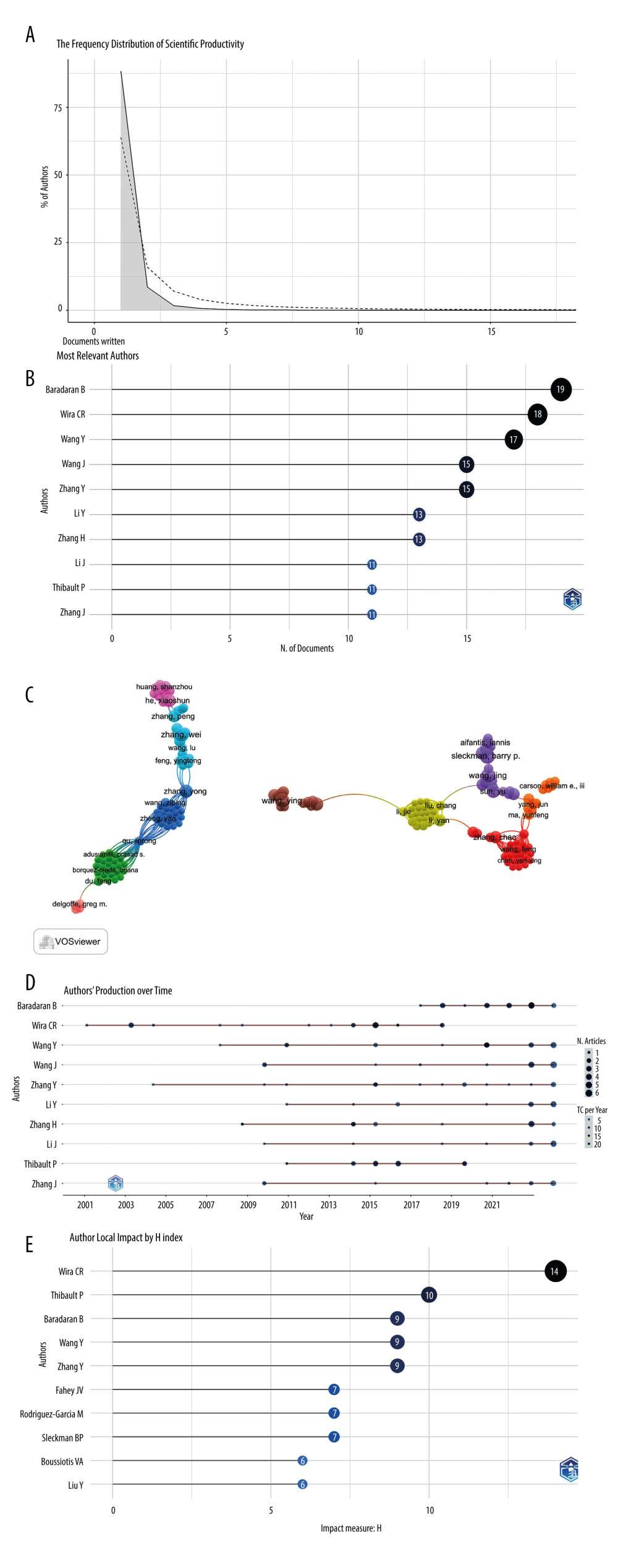 Figure 6. Analysis of core authors involved using VOSviewer (version 1.6.18) and the R package “bibliometrix”(A) The frequency distribution of scientific productivity and the top 10 authors in total publications. (B) Frequency distribution of scientific productivity.(C) Bar plot demonstrating the production of top authors with time. The line stands for the timeline of one author, color degree shows proportion to overall annual citations, whereas bubble size shows proportion to document number. (D) Bar plot showing the top 20 authors in H-index.
Figure 6. Analysis of core authors involved using VOSviewer (version 1.6.18) and the R package “bibliometrix”(A) The frequency distribution of scientific productivity and the top 10 authors in total publications. (B) Frequency distribution of scientific productivity.(C) Bar plot demonstrating the production of top authors with time. The line stands for the timeline of one author, color degree shows proportion to overall annual citations, whereas bubble size shows proportion to document number. (D) Bar plot showing the top 20 authors in H-index. 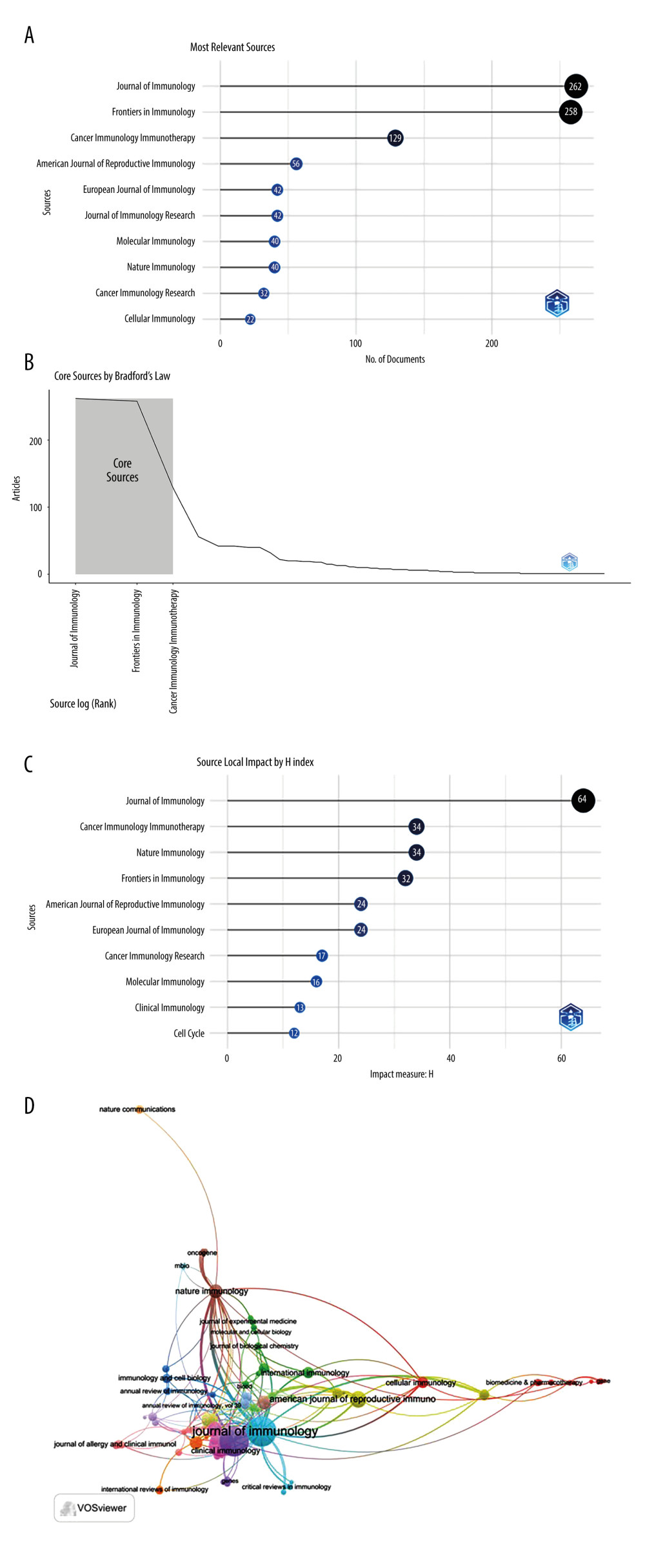 Figure 7. Analysis on the journals related to publishing articles using VOSviewer (version 1.6.18) and the R package “bibliometrix”(A) The top 20 academic journals that contributed to publications. (B) Core sources of academic journals. (C) The top 20 academic journals in H-index. (D) Network map revealing the academic journals that published research on the cancer cell cycle for immunology applications.
Figure 7. Analysis on the journals related to publishing articles using VOSviewer (version 1.6.18) and the R package “bibliometrix”(A) The top 20 academic journals that contributed to publications. (B) Core sources of academic journals. (C) The top 20 academic journals in H-index. (D) Network map revealing the academic journals that published research on the cancer cell cycle for immunology applications. 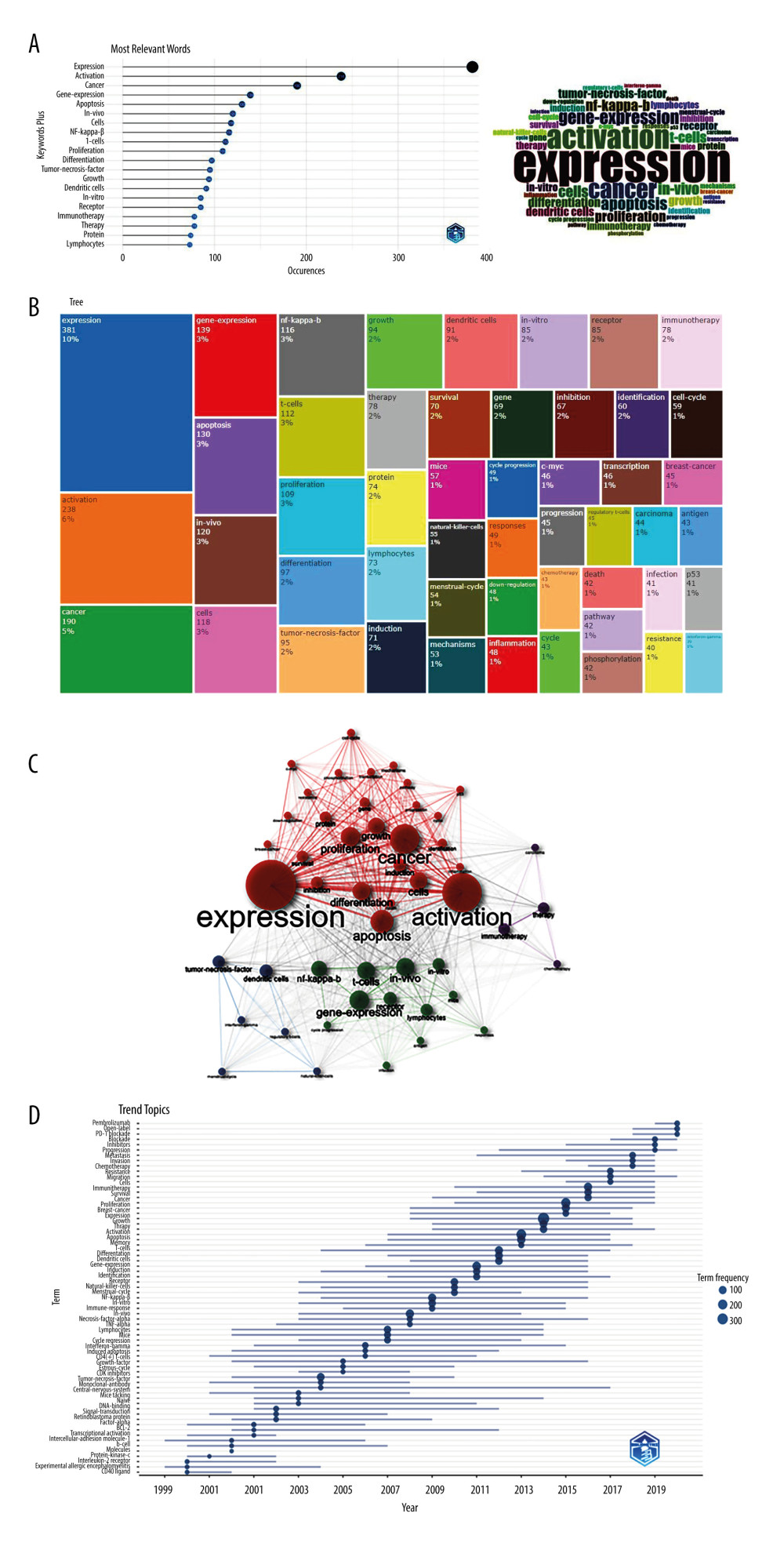 Figure 8. Analysis on the keywords involved using R (4.2.2) package “bibliometrix” and CiteSpace (5.7.R5)(A) Bar diagram showing the top 20 most frequent keywords and Word cloud displaying the top most relevant keywords. (B) Treemap of keywords demonstrating the top most frequent keywords. (C) Network map of keywords related to the cancer cell cycle for immunology applications. (D) Map of keyword trend topics in articles related to the cancer cell cycle for immunology applications.
Figure 8. Analysis on the keywords involved using R (4.2.2) package “bibliometrix” and CiteSpace (5.7.R5)(A) Bar diagram showing the top 20 most frequent keywords and Word cloud displaying the top most relevant keywords. (B) Treemap of keywords demonstrating the top most frequent keywords. (C) Network map of keywords related to the cancer cell cycle for immunology applications. (D) Map of keyword trend topics in articles related to the cancer cell cycle for immunology applications. Tables
Table 1. The 10 most prolific countries/regions associated with the topic.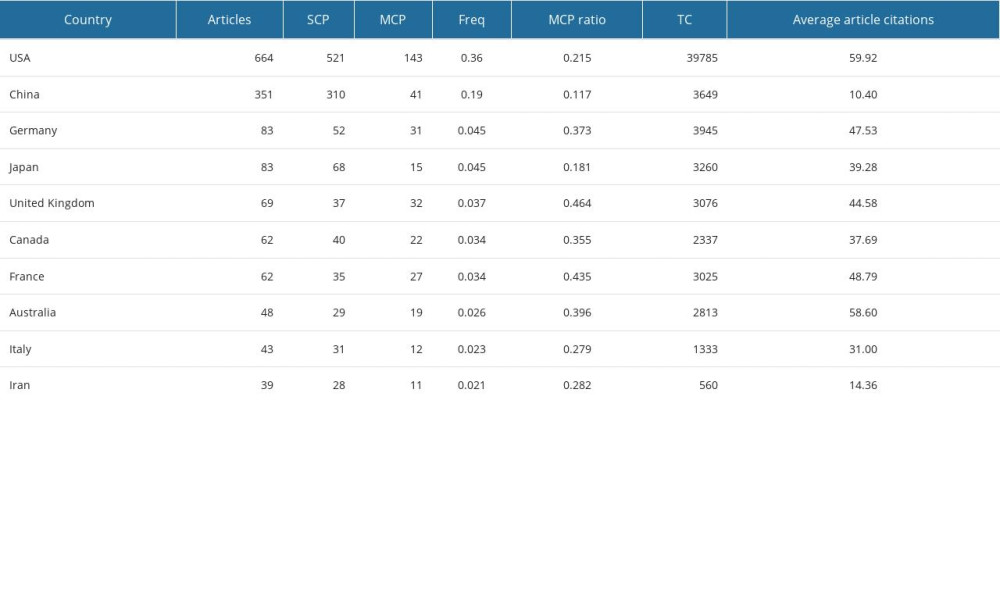 Table 2. The top 10 institutions regarding publications of cancer cell cycle for immunology applications.
Table 2. The top 10 institutions regarding publications of cancer cell cycle for immunology applications.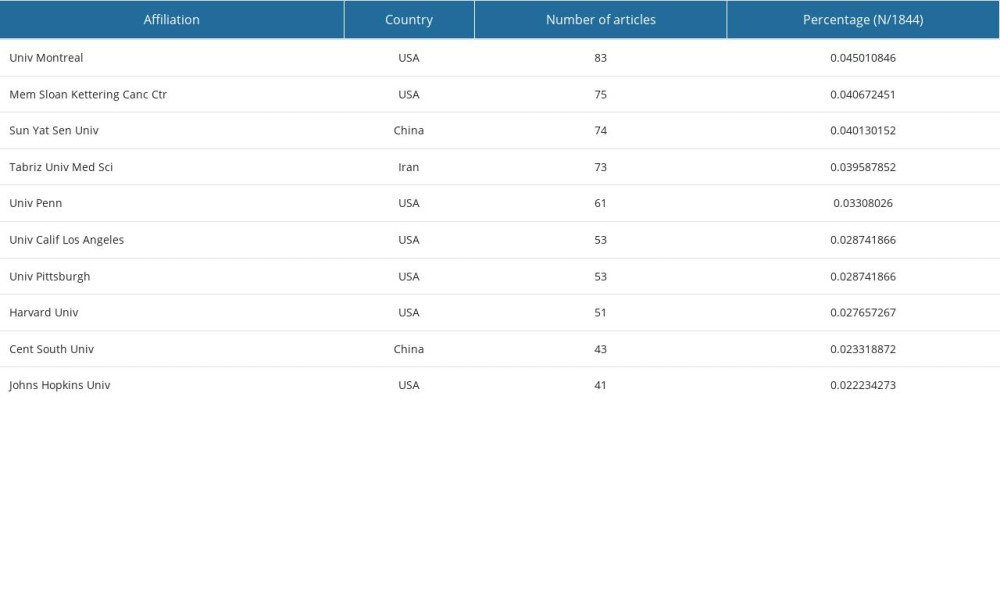 Table 3. The most local cited sources (from reference lists).
Table 3. The most local cited sources (from reference lists).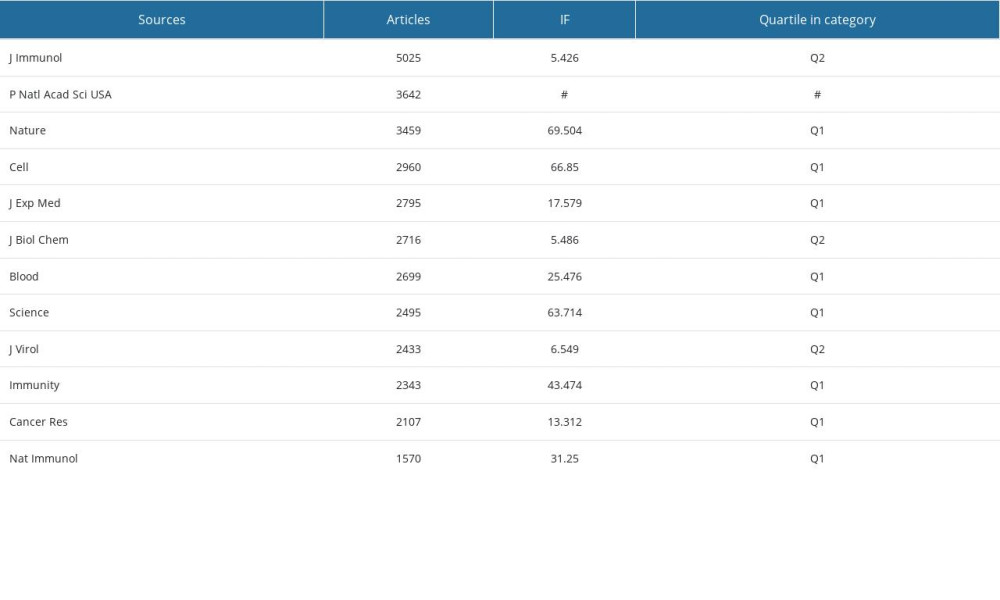 Table 4. The most global cited documents.
Table 4. The most global cited documents.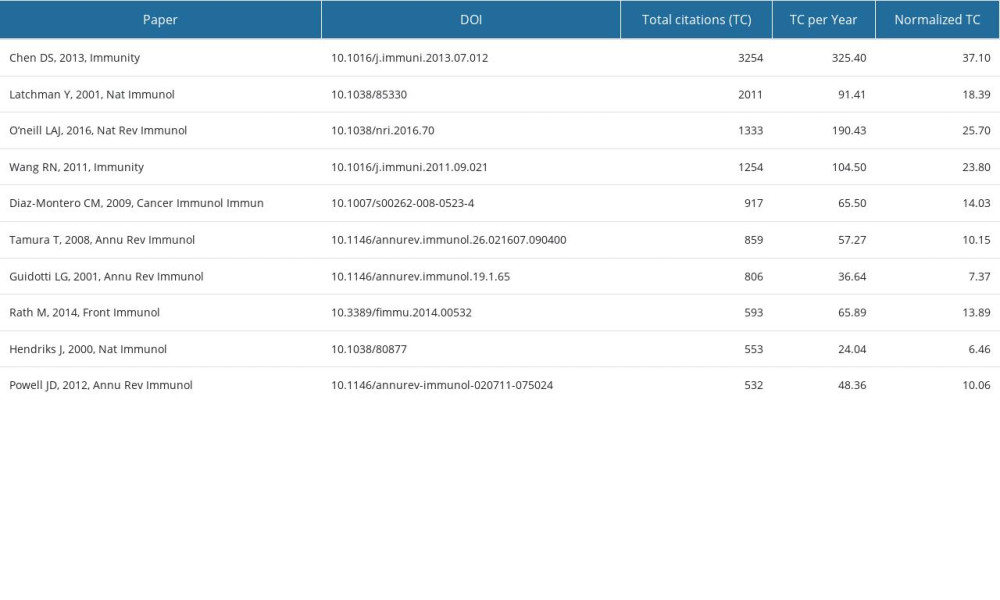 Table 5. The top keywords trend topics in recent years.
Table 5. The top keywords trend topics in recent years.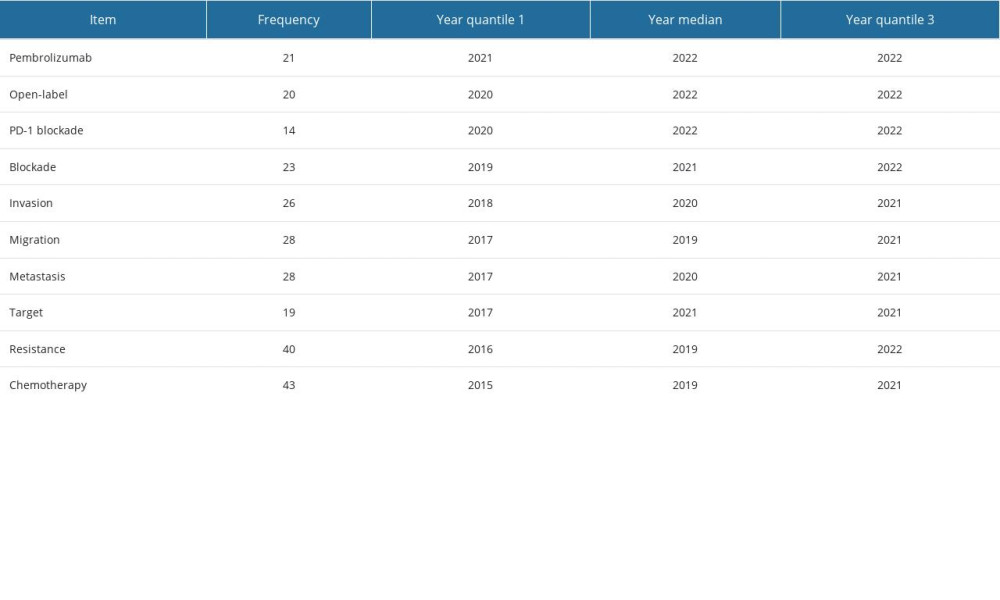
Reference
1. Zu X, Ma X, Xie X, 2,6-DMBQ is a novel mTOR inhibitor that reduces gastric cancer growth in vitro and in vivo: J Exp Clin Cancer Res, 2020; 39; 107
2. Zhang H, Christensen CL, Dries R, CDK7 inhibition potentiates genome instability triggering anti-tumor immunity in small cell lung cancer: Cancer Cell, 2020; 37; 37-54e9
3. Jirawatnotai S, Dalton S, Wattanapanitch M, Role of cyclins and cyclin-dependent kinases in pluripotent stem cells and their potential as a therapeutic target: Semin Cell Dev Biol, 2020; 107; 63-71
4. Goel S, DeCristo MJ, Watt AC, CDK4/6 inhibition triggers anti-tumour immunity: Nature, 2017; 548; 471-75
5. Minton K, Cell cycle inhibitors boost tumour immunogenicity: Nat Rev Immunol, 2017; 17; 529
6. Doroshow DB, Bhalla S, Beasley MB, PD-L1 as a biomarker of response to immune-checkpoint inhibitors: Nat Rev Clin Oncol, 2021; 18(6); 345-62
7. Dorand RD, Nthale J, Myers JT, Cdk5 disruption attenuates tumor PD-L1 expression and promotes antitumor immunity: Science, 2016; 353; 399-403
8. Zhang J, Bu X, Wang H, Cyclin D-CDK4 kinase destabilizes PD-L1 via cullin 3-SPOP to control cancer immune surveillance: Nature, 2018; 553(7686); 91-95
9. Santaguida S, Richardson A, Iyer DR, Chromosome Mis-segregation generates cell-cycle-arrested cells with complex karyotypes that are eliminated by the immune system: Dev Cell, 2017; 41(6); 638-51e5
10. Yang H, Wang H, Ren J, cGAS is essential for cellular senescence: Proc Natl Acad Sci USA, 2017; 114; E4612-20
11. Chen J, Harding SM, Natesan R, Cell cycle checkpoints cooperate to suppress DNA- and RNA-associated molecular pattern recognition and anti-tumor immune responses: Cell Rep, 2020; 32; 108080
12. Baldominos P, Barbera-Mourelle A, Barreiro O, Quiescent cancer cells resist T cell attack by forming an immunosuppressive niche: Cell, 2022; 185; 1694-1708e19
13. Kumar S, Schoonderwoerd MJA, Kroonen JS, Targeting pancreatic cancer by TAK-981: A SUMOylation inhibitor that activates the immune system and blocks cancer cell cycle progression in a preclinical model: Gut, 2022; 71; 2266-83
14. Omar HA, Tolba MF, Tackling molecular targets beyond PD-1/PD-L1: Novel approaches to boost patients’ response to cancer immunotherapy: Crit Rev Oncol Hematol, 2019; 135; 21-29
15. Xu D, Liu B, Wang J, Zhang Z, Bibliometric analysis of artificial intelligence for biotechnology and applied microbiology: Exploring research hotspots and frontiers: Front Bioeng Biotechnol, 2022; 10; 998298
16. Cheng K, Guo Q, Shen Z, Bibliometric analysis of global research on cancer photodynamic therapy: focus on nano-related research: Front Pharmacol, 2022; 13; 927219
17. Pei Z, Chen S, Ding L, Current perspectives and trend of nanomedicine in cancer: A review and bibliometric analysis: J Control Release, 2022; 352; 211-41
18. Van Eck NJ, Waltman L, Citation-based clustering of publications using CitNetExplorer and VOSviewer: Scientometrics, 2017; 111; 1053-70
19. van Eck NJ, Waltman L, Software survey: VOSviewer, a computer program for bibliometric mapping: Scientometrics, 2010; 84; 523-38
20. Guo S-B, Du S, Cai K-Y, A scientometrics and visualization analysis of oxidative stress modulator Nrf2 in cancer profiles its characteristics and reveals its association with immune response: Heliyon, 2023; 9(6); e17075
21. Shen J, Shen H, Ke L, Knowledge mapping of immunotherapy for hepatocellular carcinoma: A bibliometric study: Front Immunol, 2022; 13; 815575
22. Wu F, Gao J, Kang J, Knowledge mapping of exosomes in autoimmune diseases: A bibliometric analysis (2002–2021): Front Immunol, 2022; 13; 939433
23. Ma D, Guan B, Song L, A bibliometric analysis of exosomes in cardiovascular diseases from 2001 to 2021: Front Cardiovasc Med, 2021; 8; 734514
24. Matthews HK, Bertoli C, De Bruin RAM, Cell cycle control in cancer: Nat Rev Mol Cell Biol, 2022; 23; 74-88
25. Yu J, Yan J, Guo Q, Genetic aberrations in the CDK4 pathway are associated with innate resistance to PD-1 blockade in chinese patients with non-cutaneous melanoma: Clin Cancer Res, 2019; 25; 6511-23
26. Schaer DA, Beckmann RP, Dempsey JA, The CDK4/6 inhibitor abemaciclib induces a T cell inflamed tumor microenvironment and enhances the efficacy of PD-L1 checkpoint blockade: Cell Rep, 2018; 22; 2978-94
27. Deng J, Wang ES, Jenkins RW, CDK4/6 inhibition augments antitumor immunity by enhancing T-cell activation: Cancer Discovery, 2018; 8; 216-33
28. Pujol J-L, Vansteenkiste J, Paz-Ares Rodríguez L: JTO Clin Res Rep, 2021; 2; 100234
29. Icard P, Fournel L, Wu Z, Alifano M, Lincet H, Interconnection between metabolism and cell cycle in cancer: Trends Biochem Sci, 2019; 44; 490-501
30. Falcomatà C, Bärthel S, Widholz SA, Selective multi-kinase inhibition sensitizes mesenchymal pancreatic cancer to immune checkpoint blockade by remodeling the tumor microenvironment: Nat Cancer, 2022; 3; 318-36
31. Chan CY-K, Chiu DK-C, Yuen VW-H, CFI-402257, a TTK inhibitor, effectively suppresses hepatocellular carcinoma: Proc Natl Acad Sci USA, 2022; 119; e2119514119
32. Harding SM, Benci JL, Irianto J, Mitotic progression following DNA damage enables pattern recognition within micronuclei: Nature, 2017; 548; 466-70
33. Sharma P, Allison JP, The future of immune checkpoint therapy: Science, 2015; 348; 56-61
34. Mackenzie KJ, Carroll P, Martin CA, cGAS surveillance of micronuclei links genome instability to innate immunity: Nature Aug 24, 2017; 548(7668); 461-65
35. Beatty GL, Gladney WL, Immune escape mechanisms as a guide for cancer immunotherapy: Clin Cancer Res, 2015; 21; 687-92
36. Ishizuka JJ, Manguso RT, Cheruiyot CK, Loss of ADAR1 in tumours overcomes resistance to immune checkpoint blockade: Nature, 2019; 565; 43-48
37. Xu H, Yu S, Liu Q, Recent advances of highly selective CDK4/6 inhibitors in breast cancer: J Hematol Oncol, 2017; 10(1); 97
38. Lelliott EJ, McArthur GA, Oliaro J, Sheppard KE, Immunomodulatory effects of BRAF, MEK, and CDK4/6 inhibitors: Implications for combining targeted therapy and immune checkpoint blockade for the treatment of melanoma: Front Immunol, 2021; 12; 661737
39. Zhang Q-F, Li J, Jiang K, CDK4/6 inhibition promotes immune infiltration in ovarian cancer and synergizes with PD-1 blockade in a B cell-dependent manner: Theranostics, 2020; 10; 10619-33
40. Steven A, Seliger B, The role of immune escape and immune cell infiltration in breast cancer: Breast Care (Basel), 2018; 13; 16-21
41. Sen T, Rodriguez BL, Chen L, Targeting DNA damage response promotes antitumor immunity through STING-mediated T-cell activation in small cell lung cancer: Cancer Discov, 2019; 9; 646-61
42. Shen J, Zhao W, Ju Z, PARPi Triggers the STING-dependent immune response and enhances the therapeutic efficacy of immune checkpoint blockade independent of BRCAness: Cancer Res, 2019; 79; 311-19
43. Grabosch S, Bulatovic M, Zeng F, Cisplatin-induced immune modulation in ovarian cancer mouse models with distinct inflammation profiles: Oncogene, 2019; 38; 2380-93
44. Fassl A, Geng Y, Sicinski P, CDK4 and CDK6 kinases: From basic science to cancer therapy: Science, 2022; 375; eabc1495
45. Biederstädt A, Hassan Z, Schneeweis C, SUMO pathway inhibition targets an aggressive pancreatic cancer subtype: Gut, 2020; 69; 1472-82
46. Xia T, Konno H, Barber GN, Recurrent loss of STING signaling in melanoma correlates with susceptibility to viral oncolysis: Cancer Res, 2016; 76; 6747-59
47. Ma R, Liu Y, Che X, Nuclear PD-L1 promotes cell cycle progression of BRAF-mutated colorectal cancer by inhibiting THRAP3: Cancer Lett, 2022; 527; 127-39
48. Jiang M, Jia K, Wang L, Alterations of DNA damage response pathway: Biomarker and therapeutic strategy for cancer immunotherapy: Acta Pharmaceutica Sinica B, 2021; 11; 2983-94
Figures
 Figure 1. Data analysis flow chart.
Figure 1. Data analysis flow chart. Figure 2. Overall information of publications using R(4.2.2) package “bibliometrix”(A) Main information. (B) Scientific production of articles regarding cell cycle in cancer immunology each year. (C) Average article citations per year of articles regarding cell cycle in cancer immunology.
Figure 2. Overall information of publications using R(4.2.2) package “bibliometrix”(A) Main information. (B) Scientific production of articles regarding cell cycle in cancer immunology each year. (C) Average article citations per year of articles regarding cell cycle in cancer immunology. Figure 3. Top countries and relevant institutions that contributed to research on cell cycle in cancer immunology using R(4.2.2) package “bibliometrix”(A) International country map of publications; color depth stands for publication number. (B) Bar plot showing the 20 most prolific countries regarding cancer cell cycle for immunology in line with countries of corresponding authors. (C) Ten most prolific countries over time. MCP refers to multiple-country publications, while SCP indicates single-country publications.
Figure 3. Top countries and relevant institutions that contributed to research on cell cycle in cancer immunology using R(4.2.2) package “bibliometrix”(A) International country map of publications; color depth stands for publication number. (B) Bar plot showing the 20 most prolific countries regarding cancer cell cycle for immunology in line with countries of corresponding authors. (C) Ten most prolific countries over time. MCP refers to multiple-country publications, while SCP indicates single-country publications. Figure 4. Visualization of the coordination between countries regarding research on the cancer cell cycle for immunology applications using R(4.2.2) package “bibliometrix”(A) Network map showing the coordination relations between countries. (B) Network map visualizing the coordination relations between countries.
Figure 4. Visualization of the coordination between countries regarding research on the cancer cell cycle for immunology applications using R(4.2.2) package “bibliometrix”(A) Network map showing the coordination relations between countries. (B) Network map visualizing the coordination relations between countries. Figure 5. Visualization and analysis of institutions involved using VOSviewer (version 1.6.18) and the R package “bibliometrix”(A) Bar plot showing 10 most prolific institutions. (B) Production of those 10 most prolific institutions with time. (C) Network map showing related institutions.
Figure 5. Visualization and analysis of institutions involved using VOSviewer (version 1.6.18) and the R package “bibliometrix”(A) Bar plot showing 10 most prolific institutions. (B) Production of those 10 most prolific institutions with time. (C) Network map showing related institutions. Figure 6. Analysis of core authors involved using VOSviewer (version 1.6.18) and the R package “bibliometrix”(A) The frequency distribution of scientific productivity and the top 10 authors in total publications. (B) Frequency distribution of scientific productivity.(C) Bar plot demonstrating the production of top authors with time. The line stands for the timeline of one author, color degree shows proportion to overall annual citations, whereas bubble size shows proportion to document number. (D) Bar plot showing the top 20 authors in H-index.
Figure 6. Analysis of core authors involved using VOSviewer (version 1.6.18) and the R package “bibliometrix”(A) The frequency distribution of scientific productivity and the top 10 authors in total publications. (B) Frequency distribution of scientific productivity.(C) Bar plot demonstrating the production of top authors with time. The line stands for the timeline of one author, color degree shows proportion to overall annual citations, whereas bubble size shows proportion to document number. (D) Bar plot showing the top 20 authors in H-index. Figure 7. Analysis on the journals related to publishing articles using VOSviewer (version 1.6.18) and the R package “bibliometrix”(A) The top 20 academic journals that contributed to publications. (B) Core sources of academic journals. (C) The top 20 academic journals in H-index. (D) Network map revealing the academic journals that published research on the cancer cell cycle for immunology applications.
Figure 7. Analysis on the journals related to publishing articles using VOSviewer (version 1.6.18) and the R package “bibliometrix”(A) The top 20 academic journals that contributed to publications. (B) Core sources of academic journals. (C) The top 20 academic journals in H-index. (D) Network map revealing the academic journals that published research on the cancer cell cycle for immunology applications. Figure 8. Analysis on the keywords involved using R (4.2.2) package “bibliometrix” and CiteSpace (5.7.R5)(A) Bar diagram showing the top 20 most frequent keywords and Word cloud displaying the top most relevant keywords. (B) Treemap of keywords demonstrating the top most frequent keywords. (C) Network map of keywords related to the cancer cell cycle for immunology applications. (D) Map of keyword trend topics in articles related to the cancer cell cycle for immunology applications.
Figure 8. Analysis on the keywords involved using R (4.2.2) package “bibliometrix” and CiteSpace (5.7.R5)(A) Bar diagram showing the top 20 most frequent keywords and Word cloud displaying the top most relevant keywords. (B) Treemap of keywords demonstrating the top most frequent keywords. (C) Network map of keywords related to the cancer cell cycle for immunology applications. (D) Map of keyword trend topics in articles related to the cancer cell cycle for immunology applications. Tables
 Table 1. The 10 most prolific countries/regions associated with the topic.
Table 1. The 10 most prolific countries/regions associated with the topic. Table 2. The top 10 institutions regarding publications of cancer cell cycle for immunology applications.
Table 2. The top 10 institutions regarding publications of cancer cell cycle for immunology applications. Table 3. The most local cited sources (from reference lists).
Table 3. The most local cited sources (from reference lists). Table 4. The most global cited documents.
Table 4. The most global cited documents. Table 5. The top keywords trend topics in recent years.
Table 5. The top keywords trend topics in recent years. Table 1. The 10 most prolific countries/regions associated with the topic.
Table 1. The 10 most prolific countries/regions associated with the topic. Table 2. The top 10 institutions regarding publications of cancer cell cycle for immunology applications.
Table 2. The top 10 institutions regarding publications of cancer cell cycle for immunology applications. Table 3. The most local cited sources (from reference lists).
Table 3. The most local cited sources (from reference lists). Table 4. The most global cited documents.
Table 4. The most global cited documents. Table 5. The top keywords trend topics in recent years.
Table 5. The top keywords trend topics in recent years. In Press
18 Apr 2024 : Clinical Research
Comparative Analysis of Open and Closed Sphincterotomy for the Treatment of Chronic Anal Fissure: Safety an...Med Sci Monit In Press; DOI: 10.12659/MSM.944127
08 Mar 2024 : Laboratory Research
Evaluation of Retentive Strength of 50 Endodontically-Treated Single-Rooted Mandibular Second Premolars Res...Med Sci Monit In Press; DOI: 10.12659/MSM.944110
11 Mar 2024 : Clinical Research
Comparison of Effects of Sugammadex and Neostigmine on Postoperative Neuromuscular Blockade Recovery in Pat...Med Sci Monit In Press; DOI: 10.12659/MSM.942773
12 Mar 2024 : Clinical Research
Comparing Neuromuscular Blockade Measurement Between Upper Arm (TOF Cuff®) and Eyelid (TOF Scan®) Using Miv...Med Sci Monit In Press; DOI: 10.12659/MSM.943630
Most Viewed Current Articles
17 Jan 2024 : Review article
Vaccination Guidelines for Pregnant Women: Addressing COVID-19 and the Omicron VariantDOI :10.12659/MSM.942799
Med Sci Monit 2024; 30:e942799
14 Dec 2022 : Clinical Research
Prevalence and Variability of Allergen-Specific Immunoglobulin E in Patients with Elevated Tryptase LevelsDOI :10.12659/MSM.937990
Med Sci Monit 2022; 28:e937990
16 May 2023 : Clinical Research
Electrophysiological Testing for an Auditory Processing Disorder and Reading Performance in 54 School Stude...DOI :10.12659/MSM.940387
Med Sci Monit 2023; 29:e940387
01 Jan 2022 : Editorial
Editorial: Current Status of Oral Antiviral Drug Treatments for SARS-CoV-2 Infection in Non-Hospitalized Pa...DOI :10.12659/MSM.935952
Med Sci Monit 2022; 28:e935952








